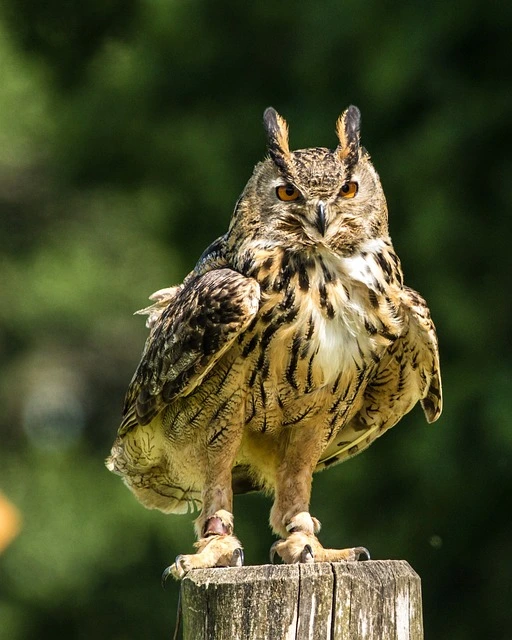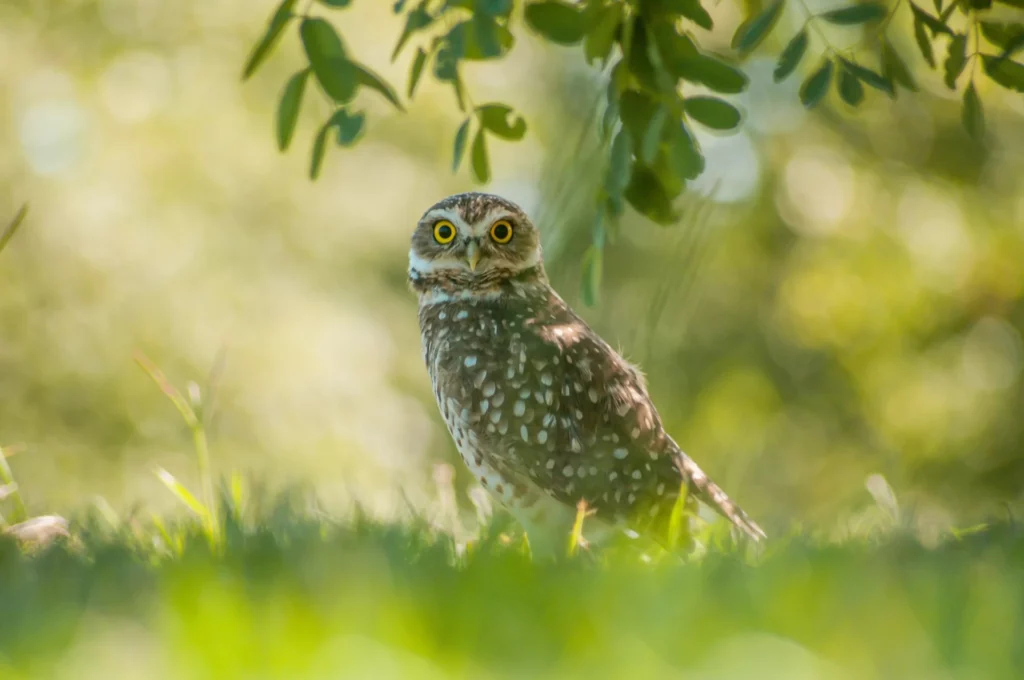When we think of the word owl, we see them preaching from a branch, their huge eyes staring into the darkness. But have you given any thought to their legs? Do owls have long legs?
Yes, owls actually do have long legs. They can reach up to half of their body length, but the surprising part is they are very thin. An owl’s legs might appear extremely slim and delicate compared to the rest of the body! These adaptations, along with short thighs and long feet, are all related to their excellent flying ability.
So, let’s discover the truth regarding owls’ long legs by exploring the science behind them.
How Long Are Owls Legs Actually?
Most people believe that owls do not have long legs. However, an owl’s legs can be up to half the length of its body. This can be seen only when their feathers are removed.
Some owls, such as snowy owls, burrowing owls, and great gray owls, are a few examples of this species that have extremely long legs.
The Anatomy of Owl Legs
To better understand the legs of an owl, we must first learn owl anatomy. Owls’ legs are powerful, muscular, and fluffy. The feathers around their legs serve various functions, including insulation and silent flight. Although an owl’s legs are small compared to its total size, they are powerful and well-suited for hunting.
Owls have sharp, curved talons on each leg, allowing them to capture and hold onto their prey. These nails are critical to their existence because they allow them to capture and kill their prey precisely. Furthermore, the flexible joints in their legs allow them to twist their feet in different directions and seize prey from different angles.
Which Owls Have the Longest Legs?

In general, we can say that the largest owl has the longest legs. The eagle owl, also known as bubo, has the longest legs. They are one of the tallest owls in the world.
The size of their legs is 20 -30 cm. The great gray owl, also a long-legged owl, measures between 24 to 33 inches, and the size of its legs are around 15 to 20 inches long.
Other types of owls, such as snowy owls, have longer legs than other owl species. The size can range from 15 -18 cm. Great horned owls have 11-13 cm long legs.
Why Do Owls Have Long Legs?
An interesting question is, why do owls have long legs? If we think technically, their long legs play a major part in their hunting strategy.
This helps the species penetrate through dense vegetation by permitting them to perch on branches and tall grass. Plus, their long legs provide balance for owls perched on top of trees.
Do Barn Owls Have Long Legs?
Barn Owls, unlike other owl species, have relatively shorter legs. On average, their legs measure around 2.5 inches, which is shorter than owls of similar size.
Although barn owls are quite popular, they don’t possess exceptionally long legs either. Despite their smaller body size, their legs are appropriately proportioned.
As with other owl species, the illusion of long legs in barn owls is primarily created by the arrangement of their feathers and unique body proportions. Therefore, if you ever encounter a barn owl, don’t be deceived by its elongated legs!
What Are Some Facts About Owl Legs?
Here are some fascinating details regarding owl legs at rest:
- The precise catching and grasping of their prey are made possible by the nails on owl legs, which are sharp.
- Owls can swivel their feet up to 270 degrees because of the flexible joints in their legs.
- An owl’s legs are covered in feathers that conceal and protect from harsh temperatures.
- To facilitate movement and for protection, owl legs are covered in scales resembling those of reptiles.
- Owls use a unique adaptation termed “powder down” to maintain their feathers healthy and waterproof. By using special feathers on their legs, this powdery substance is created.
Can Owls Stand on One Leg?
Owls can stand on one leg. Owls can balance on a single leg for long periods of time compared to other bird species. This scenario is frequently seen when owls are resting or poised.
They conserve energy and maintain stability by standing on one leg while they rest or wait for prey.
Can Owls Walk?
Owls are indeed better adapted for flying and gliding rather than walking. Their wings are designed for efficient flight, allowing them to navigate the air safely. Owls have unique feathers that allow for silent flying and sneak up on their prey without being noticed.

Even though they can travel short distances on foot if necessary, owls prefer to perch or fly rather than walk. Their legs and feet are designed specifically for gripping and perching on tree branches and other surfaces.
Owls can grasp and hold onto their prey because of their powerful talons and razor-sharp claws. Because of their modifications, they are well suited to hunting and capturing prey from a perch.
What’s the Best Way to Catch an Owl Walking?
A truly unique sight is an owl walking. Owls are well known for their mysterious personality and propensity to perch or fly. Keep your distance, and don’t bother an owl if you see it walking on the ground.
Because owls are so sensitive to people getting in their way that they may experience unnecessary stress or be unable to carry out their natural behaviors. Therefore, if you see an owl walking, the best action is to observe it from a safe distance and let it continue.
Do All Owl Species Have Long Legs?
Do owls have long legs? “Yes”. But does all the owl species have the same? “NO”. Not all owls have long legs. Owls usually have shorter legs than their bodies. As mentioned in this article, some owls, such as eagles, great gray, snowy, etc., have long legs.
Most of the owl species have legs proportionate to their body. In summary, owls with long legs are the exception, not the rule.
Can Owls Back Up?
Owls have limited ability to back up, primarily due to the structure and flexibility of their legs. Unlike other bird species, owls cannot easily walk or move backward.
Their legs are adapted for perching and gripping prey rather than complex movements like walking backward. However, owls are highly skilled at rotating their heads and bodies to face different directions, which allows them to navigate their surroundings effectively.
Fun Facts About Owl Legs
Here are some fun facts about owl legs:
- Owls appear to have long legs but we can’t see them as they are covered with feathers down to their toes.
- Owl legs have particular adaptations for hunting and collecting prey, including sharp nails and flexible joints.
- The owls’ legs are covered with feathers that serve as camouflage and a shield against harsh temperatures.
- Like reptiles, owls have scales on their legs that help in movement and defense.
- Some, like the Great Gray Owl, have considerably longer legs than other owl species.
- To keep their feathers clean and waterproof, owl legs manufacture a powdery substance known as “powder down.”
Comparing Owl Legs to Other Bird Species
To better know owl legs, compare them to other bird species. While owls have rather short legs, certain bird species, such as penguins, have even shorter legs. Penguins have adapted to a watery lifestyle, and their short legs make swimming and diving easy.
On the other hand, other bird species, such as flamingos, have longer legs allowing them to wade across shallow water for food. Their leg length is proportional to their feeding habits and habitat.
When comparing owl legs to those of other bird species, it is clear that leg length is the consequence of evolutionary adaptations tailored to the needs and habitat of each species.
Conclusion
Owl legs are unique and vital to these majestic birds’ survival and hunting strategies. Their length, anatomy, and adaptations contribute to their remarkable hunting abilities and survival in their respective habitats.
Understanding and studying owl legs is essential for the success of conservation efforts aimed at protecting these remarkable animals.
By preserving their habitats and assuring the health of their prey populations, we can protect the future of owls and preserve the delicate balance of the ecosystems in which they live. Hopefully, you got all the answers regarding “Do owls have long legs?”

